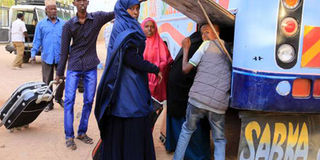UNHCR re-emphasizes stance on mode of repatriation of refugees

Some Somali refugees board a bus in Daadab to return to Somalia on June 16, 2016. UNHCR did not specifically endorse the rights group's allegations that Kenyan authorities are intimidating refugees into leaving Dadaab against their will. PHOTO | JEFF ANGOTE | NATION MEDIA GROUP
What you need to know:
- Mr Mwancha observed that more than 100,000 of those who have departed appear to have returned to Somalia without giving prior notice to UNHCR.
- Human Rights Watch reported on September 13 that some Somalis who returned to their homeland had found conditions there to be so life-threatening that they decided to go back to Dadaab.
NEW YORK
The United Nations refugee agency said on Saturday that it “shares some of the concerns” recently raised by Human Rights Watch regarding involuntary repatriation of Somalis from Dadaab Refugee Camp.
The UN High Commissioner for Refugees (UNHCR) did not specifically endorse the rights group's allegations that Kenyan authorities are intimidating refugees into leaving Dadaab against their will.
A joint communique issued on Friday by the agency and the governments of Kenya and Somalia, meanwhile characterised the reports of involuntary returns as “misinformation”.
The three parties further stated that this “negative publicity” undercuts the efforts of Kenya and Somalia in hosting and receiving the Dadaab refugees.
UNHCR emphasised in its written statement on Saturday that “central to any refugee return process is the principle of voluntariness”.
The refugee agency added: “Repatriation must be voluntary and cannot, therefore, be time-bound.”
That stated principle stands in contradiction to warnings by Kenyan officials that they intend to shut down the Dadaab complex by the end of this year.
A total of 278,000 refugees are currently living in the Dadaab camps, a UNHCR spokesman, Duke Mwancha, told the Nation on Saturday.
About 160,000 individuals have left Dadaab during the past five years, he added.
He also observed that more than 100,000 of those who have departed appear to have returned to Somalia without giving prior notice to UNHCR.
Included in Dadaab's remaining population are 40,454 “persons of concern” who were tentatively identified in a recent verification exercise as Kenyan nationals rather than Somali refugees.
Further assessments are being carried out jointly by UNHCR and the Kenyan government to determine definitively the status of these 40,454 Dadaab residents, Mr Mwancha said.
Human Rights Watch reported on September 13 that some Somalis who returned to their homeland had found conditions there to be so life-threatening that they decided to go back to Dadaab.
Kenyan authorities refused to re-admit at least a few of these returnees to Dadaab, the rights group said on the basis of interviews inside the camps in August.
INACCURATE INFORMATION
Mr Mwancha further said on Saturday that only 62 former residents of Dadaab are known to have returned from Somalia to the refugee camps in the recent past.
They have all been permitted to re-enter Dadaab, the spokesman added. “We allow them to come back if they find their situation in Somalia is not OK.”
In addition, some 4,000 first-time Somali refugees have arrived at Dadaab in recent months, Mr Mwancha added.
All of them have been assisted by UNHCR, although the Kenyan government has suspended registration of new refugees, the agency spokesman said.
UNHCR has supported 30,000 refugees in returning voluntarily to Somalia since the start of the repatriation process in December 2014.
About 14,000 of that number have left the Dadaab camps in the past four months.
But Human Rights Watch last week disputed the claim that the returns are all being carried out voluntarily.
“The Kenyan authorities are not giving Somali refugees a real choice between staying and leaving. And the UN refugee agency isn’t giving people accurate information about security conditions in Somalia,” said Bill Frelick, refugee rights director at Human Rights Watch.
“There is no way these returns can be considered voluntary.”
UNHCR said on Saturday in response to those charges that it “works closely with the government of Kenya to ensure that refugees’ rights are upheld and that solutions are found, enabling them to live in peace and security, including voluntary repatriation in conditions of safety and dignity.”
“We regularly meet with refugees and broadcast radio messages in English and Somali, emphasising that returns must be voluntary and based on an informed decision,” UNHCR added.
MEETING IN OFFING
The agency's statement also quoted Raouf Mazou, UNHCR representative in Kenya, as saying: “The complex Somali refugee situation requires a comprehensive approach to solutions, which includes continued protection for those who remain in need of asylum, adequate support for those who choose to return voluntarily, as well as other alternatives such as third-country resettlement.”
Some 2,000 returnees from Dadaab, meanwhile, find themselves in a state of suspension at transit centres in Somalia and in Dadaab, according to the communique issued on Friday by UNHCR and the governments of Somali and Kenya.
Authorities in the Jubaland region of Somalia are not permitting the returnees to proceed due to concerns about security and adequate service provision in parts of the country, which the returnees hope to reach.
A meeting at “the top level” between UNHCR and the Kenya government is planned for October to address the situation in Dadaab, Mr Mwancha said.
A repatriation process was agreed upon in 2013 by UNHCR and the governments of Kenya and Somalia.
Edited by Philip Momanyi




